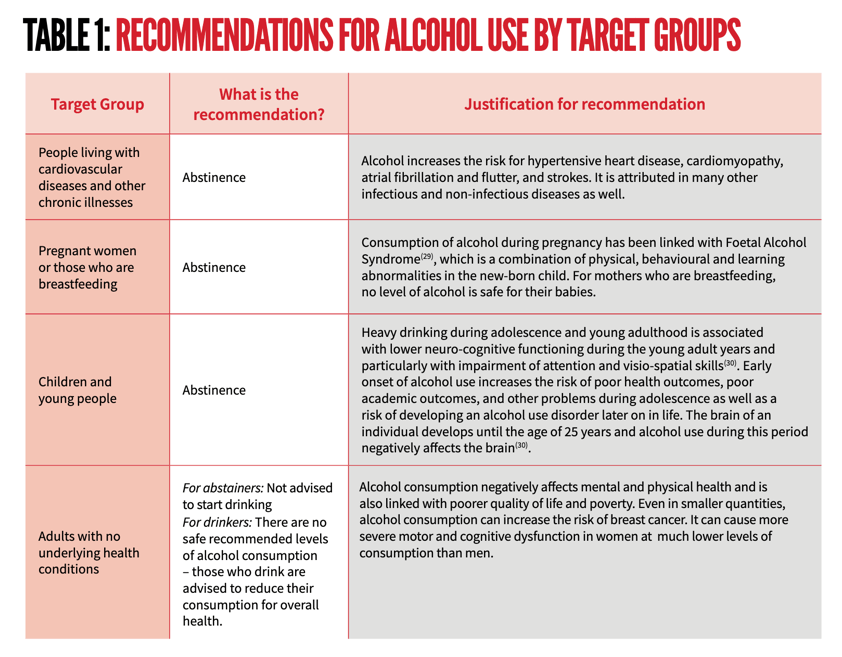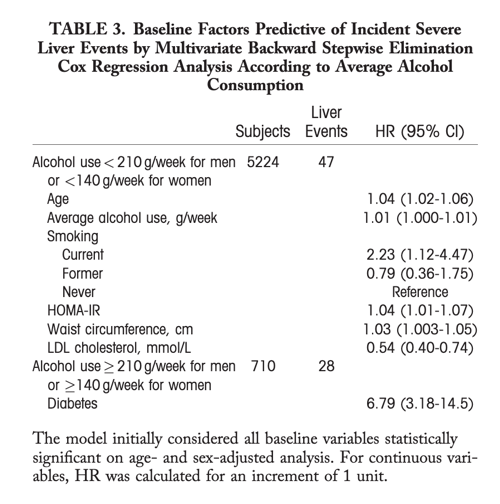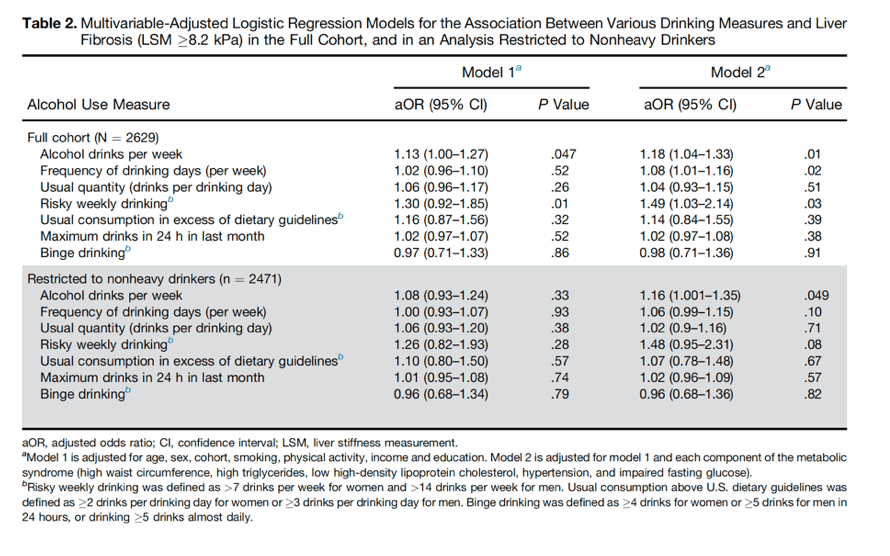| |
"no safe amount of alcohol consumption
for cancers and health can be established"
|
| |
| |
Health and cancer risks associated with low levels of alcohol consumption - Download the PDF here
No level of alcohol consumption improves health -Download the PDF here
Alcohol use and burden for 195 countries and territories, 1990-2016: a systematic analysis for the Global Burden of Disease Study 2016 - Download the PDF here
Interaction Between Alcohol
Consumption and Metabolic Syndrome
in Predicting Severe Liver Disease in the
General Population - Download the PDF here
Nonheavy Alcohol Use Associates With Liver Fibrosis and Nonalcoholic Steatohepatitis in the Framingham Heart Study - Download the PDF here
"Although we found some protective effects for ischaemic heart disease and diabetes among women, these effects were offset when overall health risks were considered-especially because of the strong association between alcohol consumption and the risk of cancer, injuries, and communicable disease."
"The conclusions of the study are clear and unambiguous: alcohol is a colossal global health issue and small reductions in health-related harms at low levels of alcohol intake are outweighed by the increased risk of other health-related harms, including cancer."
For populations aged 50 years and older, cancers accounted for a large proportion of total alcohol-attributable deaths in 2016, constituting 27°1% (95% UI 21°2-33°3) of total alcohol-attributable female deaths and 18°9% (15°3-22°6) of alcohol-attributable male deaths. In high SDI countries, cancers were the predominant source of attributable burden among both sexes. In low SDI countries, tuberculosis was the primary cause of burden for both sexes, followed by cirrhosis and other chronic liver diseases. The profile of attributable burden in high-to-middle SDI and middle SDI countries for females and males was largely composed of ischaemic stroke and haemorrhagic stroke, followed by liver cancer for females. In all SDI quintiles, haemorrhagic stroke and hypertensive heart disease were the largest sources of burden for females aged 80 years and older. For men in this age group, the composition of the burden was similar to that of males aged 50 years or older.

No level of alcohol consumption is safe for our health
Health and cancer risks associated with low levels of alcohol consumption
January, 2023
The overall risks and harms resulting from alcohol consumption have been systematically assessed and are well documented. According to the latest WHO estimates,1 alcohol consumption contributed to 3 million deaths in 2016 globally and was responsible for 5°1% of the global burden of disease and injury. Alcohol consumption is associated with an increased risk of many health conditions and is the main and sufficient cause for several disorders, including alcohol dependence, liver cirrhosis, and several other non-communicable diseases and mental health conditions. Alcohol use is among the leading risk factors for premature mortality and disability because of its causal relationship with multiple health conditions, which also include non-intentional injuries and suicides. Younger people are disproportionately affected by alcohol compared with older people, and 13°5% of all deaths among those aged 20-39 years are attributed to alcohol.1
Disadvantaged and vulnerable populations have increased rates of alcohol-related death and hospitalisation.1
Alcohol, as classified by the International Agency for Research on Cancer, is a toxic, psychoactive, and dependence-producing substance and a Group 1 carcinogen that is causally linked to seven types of cancer, including oesophagus, liver, colorectal, and breast cancers.2 Alcohol consumptions is associated with 740 000 new cancer cases each year globally.3
In the EU, light to moderate alcohol consumption (<20 g of pure alcohol per day, which is equivalent to consumption of approximately <1°5 L of wine [12% alcohol by volume; ABV], <3°5 L of beer [5% ABV], or <450 mL of spirits [40% ABV] per week) was associated with almost 23 000 new cancer cases in 2017, accounting for 13°3% of all alcohol-attributable cancers and for 2°3% of all cases of the seven alcohol-related cancer types.4
Almost half of these cancers (approximately 11 000 cases) were female breast cancers. Also, more than a third of the cancer cases attributed to light to moderate drinking (approximately 8500 cases) were associated with a light drinking level (<10 g per day).4 Increasing levels of alcohol use are associated with increasing levels of risk of illness and mortality,5, 6
leading to the question of whether a safe level of alcohol consumption that is associated with zero risk of health consequences can be defined. To identify a safe level of alcohol consumption, scientific evidence is required to show the absence of increased risk of illness or injury associated with alcohol consumption at and below that level. Some, but not all, studies have suggested that light alcohol consumption could have a small protective effect, as measured by the risk of some cardiovascular diseases or type 2 diabetes.7, 8
Some studies show the existence of such effects on certain types of cardiovascular diseases in middle-aged and older people.9 However, several reviews also found that the protective effects of moderate consumption disappear with heavy episodic drinking, which increases the risk of any cardiovascular diseases.5,10
No studies have shown that the potential existence of a protective effect for cardiovascular diseases or type 2 diabetes also reduces the risk of cancer for an individual consumer. Evidence does not indicate the existence of a particular threshold at which the carcinogenic effects of alcohol start to manifest in the human body. As such, no safe amount of alcohol consumption for cancers and health can be established. Alcohol consumers should be objectively informed about the risks of cancer and other health conditions associated with alcohol consumption.
We declare no competing interests. All authors are staff members of WHO. The authors alone are responsible for the views expressed here and these do not necessarily represent the decisions or the stated policy of WHO.
Health risks associated with alcohol consumption
Figure 4 shows the relative risk curves for selected health outcomes, separately for females and males. Estimated relative risk curves for each health outcome are presented in appendix 2 (pp 52-140). With this analysis, we only found statistically significant evidence for the J-shaped curve for ischaemic heart disease; non-significant J-shaped curves were observed for diabetes and ischaemic stroke. For ischaemic heart disease, we found a minimum relative risk of 0°86 (0°80-0°96) for men and 0°82 (0°72-0°95) for women, occurring at 0°83 standard drinks daily for men and 0°92 standard drinks daily for women. We found no significant difference in relative risk curves for ischaemic heart disease or diabetes when estimating the curves by age. For all other outcomes, including all cancers, we found that relative risk monotonically increased with alcohol consumption (appendix 2, pp 57-146).




|
|
| |
| |
|
|
|